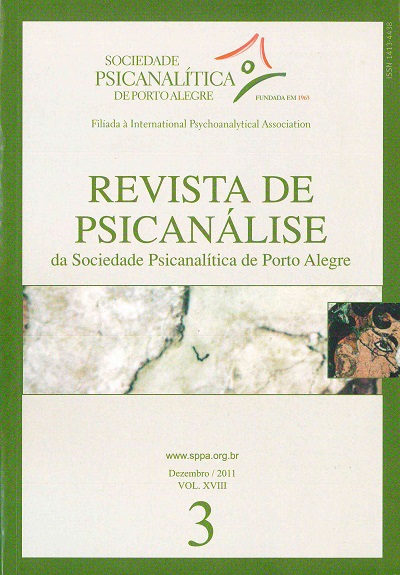Quando a Shoah é um trauma. E o pai desaparece da teoria analítica
Keywords:
Crime, Memória, Representação, Fragmentação psíquica, Sobrevivente, Transmissão transgeracional, Dor, Mothering, Grupo, Caso borderline, Anobjetalidade, Empatia, Après-coupAbstract
Interrogando as teorias psicanalíticas que se desenvolveram no pós-guerra em torno do traumatismo “extremo” sofrido pelos deportados para os campos de concentração nazistas, a autora estuda e critica o primado atribuído ao aniquilamento de toda vida psíquica no sobrevivente – com desqualificação dos mecanismos que permitem a representação psíquica, recusa de qualquer funcionamento do recalque, perda das referências simbólicas articuladas com a função paterna e prevalência dos processos empáticos – ao mesmo tempo em que, além disso, a pulsão de morte não é tida em conta. De que maneira a psicanálise respondeu com sua própria teoria do assassinato e da destrutividade, quando se constata que a barbárie teve como consequência uma modificação do marco teórico da metapsicologia? Até que ponto esse efeito não faria parte da tentativa totalitária de matar a própria psicanálise? (AU)
Downloads
References
ACKERMAN, N.; JAHODA, M. (1948). The dynamic basis of antisemitic attitudes. The Psychoanalytic Quarterly, n. 17, p. 240-260.
AGAMBEN, G. (2003). Ce qui reste d’Auschwitz. L’archive et le témoin. Rivages Poche.
AMERICAN Psychiatric Association. DSM-III: Diagnostic and statistical manual of mental disorders, 1982.
AUERHAHN, N.; PRELINGER, E. (1983). Repetition in the concentration camp survivor and her child. Int. Review Psychoanal., n. 10, p. 31-46.
. (1989). Failed empathy: a central theme in the survivor’s holocaust experience. Psychoanalytic Psychology, n. 6, p. 377-400.
. (1993). Knowing and not knowing: forms of traumatic memory. Int. J. Psychoanal., n. 74, p. 287-302.
. (1998). The primal scene of atrocity. Psychoanalytic Psychology, n. 15, p. 360-377.
BERGMANN, M.; JUCOVY, M. (Org.) (1982). Generations of the holocaust. New York: Basic Books. Com várias contribuições de Judith Kestenberg.
BERGMANN, M. (1985). Reflections on the psychological and social function of remembering the holocaust. Psychoanalytic Inquiry, n. 5, p. 9-20.
BETTELHEIM, B. (1943). Individual and mass behaviour in extreme situations. J. Abnormal and Social Psychology, n. 38, p. 417-452.
. (1967). La forteresse vide. Paris: Gallimard, 1969.
COHEN, J. (1985). Trauma and repression. Psychoanalytic Inquiry, n. 5, p. 163-189.
DANIELI, Y. (1984). Psychotherapists participation in the conspiracy of silence about holocaust. Psychoanalytic Psychology, n. 1, p. 23-42.
DES PRES, T. (1976). The survivor: an anatomy of life in the death camps. New York: Oxford University.
FREUD, S. (1920). Au-delà du principe de plaisir. In: Essais de psychanalyse. Paris: Payot e Rivages, 2001.
. (1939). L’homme Moïse et la religion monothéiste. Paris: Gallimard, 1986. p.131.
JUCOVY, M. (1985). Telling the holocaust story: a link between the generations. Psychoanalytic Inquiry, n. 5, p. 31-49.
KARDINER, A. (1941). Mon analyse avec Freud. Paris: Belfond, 1978, p. 160-161
KERTÉSZ, I. (1975). Sem destino. São Paulo: Planeta, 2003.
. (1995). Kadish: por uma criança não nascida. Rio de Janeiro: Imago, 2002.
. (2003). Liquidação. São Paulo: Companhia das Letras, 2005.
KESTENBERG, J.; BRENNER, I. (1986). Children who survived the holocaust. Int. J. Psycho-Anal.; Int. J. Psychoanal., n. 67, p. 309-316.
KOHUT, H. Oedipus vs. Narcissus [Interview]. New York Times Magazine, nov. 9, 1980.
KRYSTAL, H. (Ed.). (1968). Massive psychic trauma. New York: Int. Univ.
. (1984). Review of ‘Generations of the holocaust’. The Psychoanalytic Quarterly, n. 53, p. 466-473.
LANZMAN, C. (1986). Les non-lieux de la mémoire. Nouvelle Revue de Psychanalyse, n. 23,
, p. 11-24. Entrevista concedida à François Gantheret.
SHOAH. Dirigido por Claude Lanzmann. New York: New Yorker Films, 1985, 503 min. Documentário sobre o Holocausto.
LAUB, D. (1998). The empty circle: children of survivors and the limits of reconstruction. J. American Psychoanal. Association, n. 46, p. 507-529.
LEVI, P. Si c’est un homme. Paris: Pocket, 2003, p. 138-139.
LOEWENSTEIN, R. ([1951]1952). Psychanalyse de l’antisémitisme, PUF.
MARCUS, P.; WINEMAN, I. (1985). Psychoanalysis encountering the holocaust. Psychoanalytic Inquiry, n. 5, p. 85-98.
MOSCOVICI, M. (1989). Un meurtre construit par les produits de son oubli. In: Il est arrivé quelque chose. Paris: Ramsay, p. 387-416.
NIEDERLAND, W. (1961). The problem of survivor. J. Hillside Hospital, v. 10, p. 233-247
Published
How to Cite
Issue
Section
License
Atribuo os direitos autorais que pertencem a mim, sobre o presente trabalho, à SPPA, que poderá utilizá-lo e publicá-lo pelos meios que julgar apropriados, inclusive na Internet ou em qualquer outro processamento de computador.
I attribute the copyrights that belong to me, on this work, to SPPA, which may use and publish it by the means it deems appropriate, including on the Internet or in any other computer processing.
Atribuyo los derechos de autor que me pertenecen, sobre este trabajo, a SPPA, que podrá utilizarlo y publicarlo por los medios que considere oportunos, incluso en Internet o en cualquier otro tratamiento informático.










